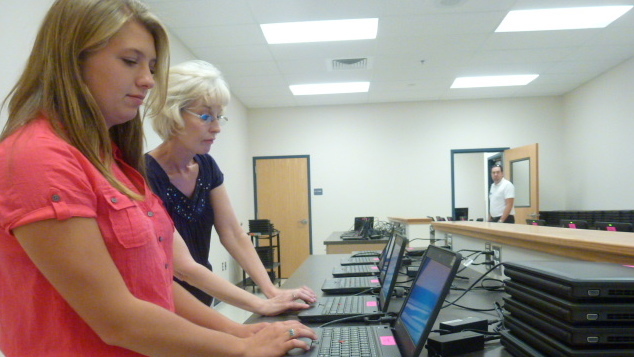EDITOR’S NOTE: Eleven Idaho schools are launching on an experiment this fall. They are using $3 million in state grants to try out methods of using technology in the schools. This is the second of a series of stories on the grant recipients.
The Lenovo ThinkPad laptops, stacked in a computer room at Middleton High School, will soon be used as classroom learning tools.
But that’s just part of the plan. School administrators believe the devices will also help the school’s 1,085 students learn to function in the computer-driven society that awaits after graduation. Over the next two years, Middleton will spend $427,872.40 in state grant money putting this theory to the test.

Principal Mike Williams admitted to some initial jitters in July, after learning Middleton was one of 11 schools to receive a share of the $3 million in grants. “It went from elation to panic,” he said this week. However, Middleton officials have systemic, strategic change in mind — and envision the laptop program as the next step in transforming the school’s culture.
Middleton calls its technology pilot project Go One-Go On, an outgrowth of the school’s drive to encourage graduates to pursue a postsecondary education.
Last year, Middleton made the Go On program a priority — and was honored as “Go On School of the Year” by the J.A. and Kathryn Albertson Foundation. In its application for a state technology grant, school officials rattle off some big numbers. Students logged onto Career Information Systems, a college and professional planning site, a staggering 28,402 times. Students took 855 practice college entrance exams, and made 677 inquiries to colleges.
And all of this happened with limited computer access: Students were only able to get lab time weekly. When Middleton students receive their laptops — most likely in the next week or two, Middleton IT coordinator Mike Cozakos says — the students will be ensured daily computer access.
A recurring theme of the Middleton program is preparing students for life after high school:
- It’s no accident that Middleton opted for laptops that use a Windows-based operating system. Windows provides better access to educational material, Cozakos says, and it also exposes students to the operating system that is most used in the workplace.
- When students receive their laptops, they will receive training almost immediately. One of the first topics will be in digital citizenship and in combating cyberbullying, to help students understand how they should and should not conduct themselves online, said Paige Goodson, the school’s technology integration specialist.
- Starting this year, students will develop an online portfolio as their senior project. The idea is to require students to create a useful document that contains their academic data — while getting valuable experience in website design.
- Middleton students will staff the IT help desk; they’re already on the job, labeling the computers and getting the devices ready for the rollout. For students who want to pursue an IT career, the internships will give them a chance to earn certification that puts them ahead of their peers, Cozakos said. But even for interns who pursue another career path, the problem-solving skills developed on the help desk should be valuable, Goodson said.
Middleton has already shown marked academic improvement. As recently as 2010-11, the school failed to achieve Adequate Yearly Progress, the state’s accountability yardstick under the federal No Child Left Behind law. In 2012-13, Middleton was a five-star school, receiving the maximum rating on the state’s report card.
School officials hope to use the laptop program to build on online academic programs already in place. One, My Big Campus, uses elements of social networking to provide students a place where they can collaborate with classmates or get feedback from their teachers. Another — Google Apps for Education, or GAFE — is a free program that encourages collaboration and use of cloud storage.
For some students, these are familiar concepts. But in a school where half of the students are eligible for free and reduced lunch, the laptop program is a way to bridge demographic gaps. For Williams, one student’s reaction sums it up: “’Now I’m on an equal playing field with everybody else.’”
Disclosure: Idaho Education News is funded through a grant from the J.A. and Kathryn Albertson Foundation.
More reading: Learn about Kuna Middle School’s Chromebooks project.
